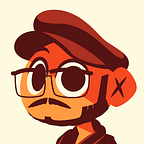Interesting = Story
We, humans, crave stories like we crave food. We seem to love the sense of wonder, intrigue, and discovery that storytelling allows us to participate in.
We can see something beautifully done, like a cool drawing, for a couple of minutes and go “wow, that’s cool”, but few of us will stare at it for hours. Yet, many of us would binge watch 37 episodes of an animated series if we have the time and space to do it.
The reason is simple, the series feels more interesting because is telling us a clearly defined story.
What’s a story?
At its simplest form, a story is but a series of information pieces that build upon each other to compose something bigger than their mere addition.
Bob Ramírez is a dude, Steve Ramírez is a dude, but Bob and Steve Ramírez are more than two dudes. They could be brothers, cousins, father and son, a lucky coincidence, and so on.
By placing Bob Ramírez and Steve Ramirez next to each other we’re starting to create a space where something bigger than them can easily flourish.
Drawing is visual storytelling
How many times have we heard the phrase: “an image is worth more than 1000 words”? Well, it will come as no surprise that our drawings and cartoons are images, therefore, stories.
Every draw we make, from the simplest character design to an elaborated composition, is telling a story. It is not even a matter of choice to tell a story or not; the only true choice while making a drawing is to care about what’s being told or not.
In the special case of cartoons, they can be defined (by their level of abstraction) as a group of often clever references to real elements. Cartoons are not only telling a story but making the viewer participate in the discovery of the narrative.
How to tell a story with cartoons
The most evident form of cartoon visual storytelling is comics (sequential art for the refined ones), a series of drawings that let us discover the development of a story. Both in their overall multi-drawings scale, and it’s small single drawing scale.
Every frame and drawing in a comic book narrates a small story on itself. The composition, lighting, expressions, textures, and so on are all adding information that builds upon the previous to be a solid platform for new things.
To make our drawings story-driven (interesting) we should:
- State a clear communicative intention with them (set on a story to narrative).
- Ensure that every element on the drawing contributes to telling the story, eliminating everything that’s not necessary and reshaping the remaining elements in a way that pushes the narrative forward.
What makes a story interesting?
Beyond style and technique in the rendering of drawings we could argue that at its core, a good story fulfills the following conditions:
- It’s consistent, every element that is inside it seems to belong or fit in there.
- Keeps us wondering, expecting, making questions.
- It allows us to make discoveries, leaving us clues and spaces to find more things in the story.
- It surprises us, via our own discovery or drastic reveals, good stories manage to present things we couldn’t have seen coming and suddenly change several of our notions around it.
Story comes first
It really doesn’t matter how “good” of an artist we are regarding technique; we just have to be good enough to tell our story. Story comes first: style and technique are things that support our narrative, they don’t define it.
The reason why a comic like Peanuts (Charlie Brown) ran for decades and is still relevant today. even when Charles Schultz wasn’t the greatest drawing master of all time, is because it relates and builds stories upon our collective childhood emotions, joys, and frustrations.
The limit to tell our stories with drawings is literally our imagination, the context we choose to build a story and how we adjust our technique to support our narrative, we don’t have to be drawing masters to tell good stories, just good enough artists to carry them over.
Final Pro-Tips
- Don’t mind the size: A good story does not mean a long story. We can just visit twitter to corroborate this.
- Tell the stories you wanna consume: Have fun, tell things you enjoy. Everything else will follow.
- In doubt, go random: If we ever get stuck we should just grab two random things, mix them and see what happens. An orange and a ninja? why not. This could be the start of Vitamin C of the shadows, legacy of the seedless.
If you have any thoughts, opinions or will like to consult me at something you can DM on twitter at @manuelberbin or email me at hola@manbe.me, if you got here and want to know a little more about me:
My name is Manuel Berbin, you can call me Manbe for short. I specialize in 2d vector cartoon illustration and concept development. I’ve been drawing cartoons my whole life and illustrating professionally at digital media for over 9 years. I was born in Venezuela but I’m currently living in Buenos Aires, Argentina.
If you want to see my 2D illustration work, you can check:
For quick recaps of this articles on presentation formats you can check my Instagram account:
